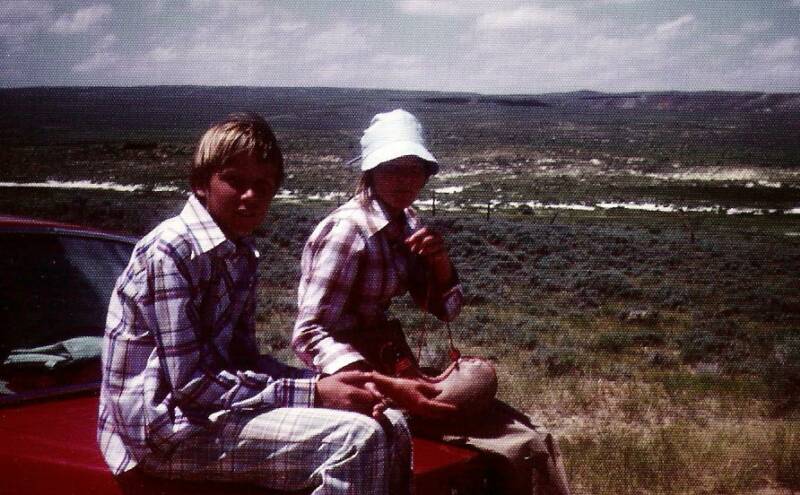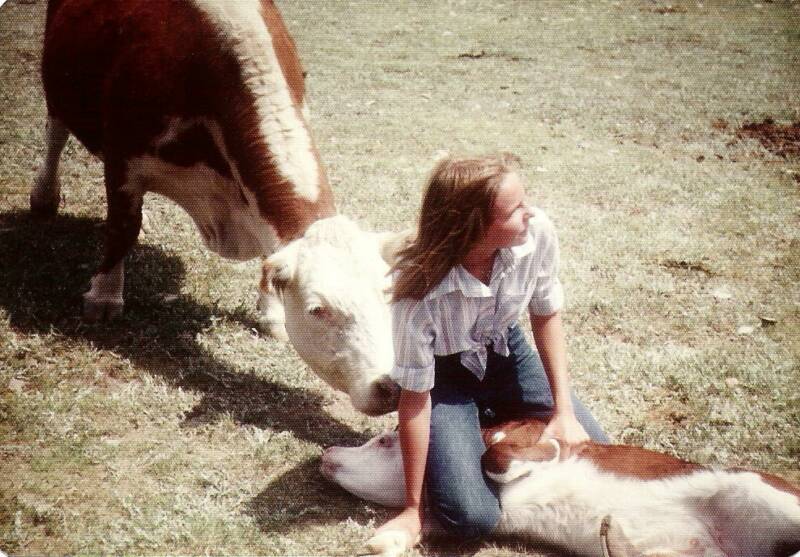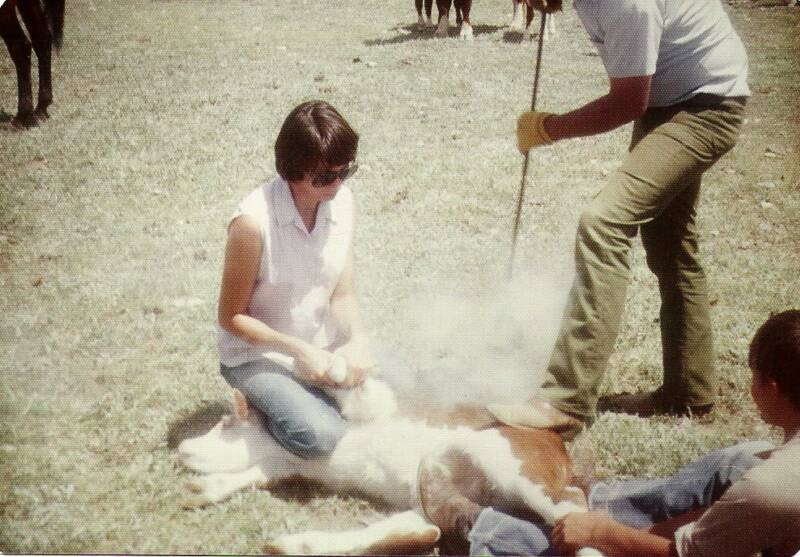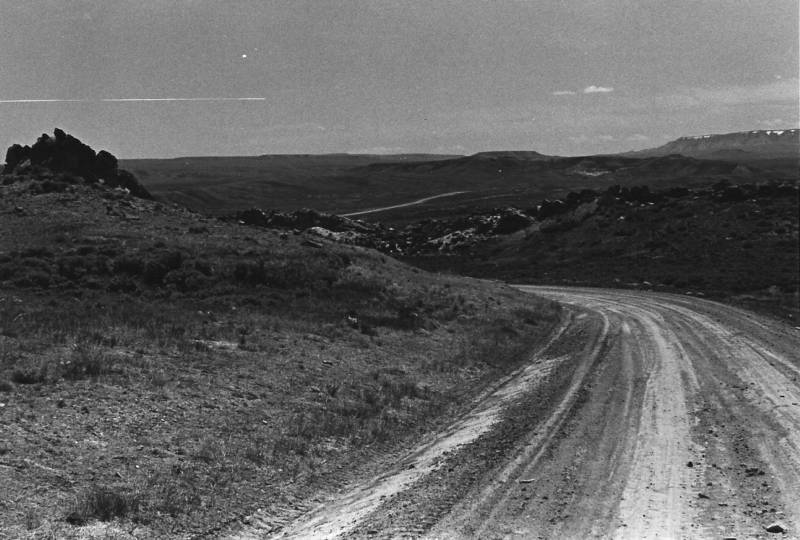FAMILY
July 7 - 17
(140 miles)
July 7 - 17
(140 miles)
When I first started the trip there were tentative plans that my family would join me vaguely somewhere ''out there" when school was out. I had repeatedly used the image of the ''family walking together later on'' in relating to strangers because somehow the image of mother and family was reassuring to strangers. Actually I had thought very seldom of the time we would be together so that when they actually arrived it was almost a surprise. It had became obvious by any glance at a map, however, that the family as a support system would be absolutely essential for the next stretch through south western Wyoming if I were to walk anywhere near the original trail. Not only would it have been foolhardy to attempt the unknown route alone, but it would have been impossible to carry adequate water and food supplies without help.
So I waited at Glenda's cottage in Casper. On Friday morning I recognized the sound of our car's motor and then the sound of Howard's voice (my husband) and then I saw them all. Paula, my daughter, almost 15, was grinning and my son Cliff, age 14, shocked me by having grown taller and needing a haircut badly. In seconds it felt like we'd never been apart.
We spent the afternoon buying supplies. In the evening utterly exhausted, we tried to get organized for a 4:30 departure in the morning. We were all tense and snappy by the time we fell asleep. During the night Cliff called, "Get me a pan; I'm going to throw up.'' Paula said, "I have a wicked bad pain in my side." And I thought, "Us? Backpacking for 4 days? Alone? In the [167] middle of nowhere?!!" And then I realized, "We must take the car." And immediately fell asleep.
A local TV station did some filming and taping on our first morning on the trail. So much for the image of the family gathered together with warm pride for the mother! On the TV interview the kids were decidedly unenthusiastic. "What do you think about walking the trail with your mother?" Cliff, "It's boring." "Paula, what do you think of your mother doing this?" "It's alright."
Near the end of the first day, hot, exhausted, miserable, Paula burst into tears of rage and frustration when her golf cart snagged on a boulder. "Mom," she said evenly, her voice tightly controlled. ''This trip is your thing. This is not my thing. I hate it."
From then on, I was the only one that pulled a golf cart. The others carts were stashed in the trunk for good.
At the end of our walking for the first day we plopped down in an empty school yard. Paula leaning limply against a wall, ''Usually I'd be bored doing this but now I'm just glad to be sitting." Then with their exasperatingly quick recovery rate, both kids were soon exploring, and finding baby birds and ''taming'' a baby rabbit.
That night Paula and I slept out side under the stars. Middle of night, started to rain, Paula ran to the tent and I (the rugged pioneer) retired to the car. We fell asleep and then WHAM! Hail!! I in the car was shocked with the sudden fury of the storm (which damaged cars in Casper). I held the car door open a crack for emergencies and shined the flashlight for a beacon. The hail whitened my knuckles and poured in the crack. Outside I got an occasional glimpse, through lightening, of what was the little tent, [168] but it was so grotesquely out of shape, it didn't look like a tent. (Howard, I learned later, was inside holding up the pole desperately). The hail and howling wind and thunder and lightening, what was happening out there?! The fury subsided slightly and Paula darted to the car soaked and shivering violently. Suddenly the storm moved on and the lightening flashed to the south as the stars shone overhead despite some lingering rain. Whew! Thank God we had the car!
Next morning; fresh, delightful, saw elk, antelope. The broad trail running across the prairie that we grooved on and followed breathlessly turned out to be the Oregon Trail alright, but the gas company had gone right down it for miles, dug it up, laid lines, etc. Quite disillusioning!
Up the big big pull, Rattlesnake Range, an air of tension hovering with the blobs of building storms in various directions and the large herd of cattle milling ahead, behind and to the south. Suddenly off to the north the ruts (freed from the gas line mutilation) pulled in a wide swale up the hill. Their very appearance emanated a sense of strain and exhaustion. Near the top the cattle departed in a noisy clamber of hooves, and then the highest point, physically and emotionally of the journey so far. Was I gasping from the long pull or the sight before me? In the distance the jagged horizon of the honest genuine Rocky Mountains, at last, range upon range behind range fading forever into the distant mists, black and violet and gray and blue and a vast breathtaking space of emptiness ahead between my hilltop and the mountains and a thin bright skyline above the mountains and then massive rolling thunderheads, black and turbulent emitting dramatic shafts of light here and there as if to heighten the dynamic throbbing of the soaring miles. The frail dirt road tilted downward for nine miles, nine miles of exhilaration. I went on with a wary eye on the distant lightening and a communing [169] attention on the precious trail ruts accompanying me to the north. We camped half way down the nine mile descention, not a tree in sight, just the tiny dot of our car on the hundreds of square miles of small sagebrush clumps and white flashing antelope rumps.
That night I slept like a rock, foolishly gripping my sleeping bag tightly around my neck to keep out rattlesnakes. I didn't even hear the coyotes sing, the loudest and closest Howard had ever heard. In the morning the still dawn air had allowed the dew to collect and soak through my sleeping bag. The cloudless bright sunny sky did a remarkable transformation of last night's awesome scene. It flattened it with a brown desert-like frightening expanse, no longer the optimistic beckoning of the night before. Did the pioneers see it both ways?
The kids and I started off down hill startling herds of antelope. We all bath-roomed behind our own selected too tiny sagebrush clumps and walked on.
We took the actual Oregon Trail ruts for the last 5 or 6 miles very very realistic on the flat desert like expanse, the scene virtually unchanged to what the pioneers saw, exciting! Independence Rock lay ahead.
The kids and I continued on the actual ruts toward Independence Rock. Horse silhouettes, Steamboat Rock, rock mesas, soda lakes, bird nests with eggs right on the ruts on the ground, alkali lakes (tiny glorified puddles smelling chemical, crusty) dramatic swale and we right in the middle and then the Deer flies came and the horror show was on; Cliff frantic, Paula in tears. The swale became a hard packed sand claylike pavement, a treat but unappreciated. The bugs blew away with the breeze, but the fear of their return ruined the walk.
Thus was the dreaded section of trail where a hundred years ago the [170] stench of rotting carcasses polluted the air. The thirst crazed animals would break from their traces to gulp the alkali water and die ironically only a few yards from the life saving Sweetwater ahead.
Independence Rock, an elongated dome of granite rock sits squarely in the middle of the campgrounds the pioneers used upon first reaching ''the dearest little stream this side of heaven," the Sweetwater River. Dazed and recovering from their agonizing dry drive from the Platte River in Casper to this the Sweetwater, the emigrants must have counted their blessings (or their losses) grimly as they recuperated by the clear sparkling water. It was an interlude conducive to leaving their own personal marks of survival which they did by carefully, proudly, and with the artistic calligraphy of that time chiseling their names and dates into Independence Rock, called the great registry of the desert.
The graffiti of the pioneers bears little resemblance to today's crude and sloppy vandalism. It took time and patience to chisel the flawless block letters into the hard granite. It was amusing to see the work of a latter day traveler who scribbled his own name and statistics sloppily with a can of red spray paint. Nearby the exquisite handiwork of a pioneer carver still defied the elements after 100 years. Times have changed our styles if not our basic impulses to lease a mark.
Unfortunately, we were not able to do justice to Independence Rock. The hot wind and the dry alkali dust laden air sapped our enthusiasm and Howard went into a near panic to get to water and shade. With detached amusement the kids and I had observed his preoccupation with water through the dry stretch just covered. ''Everything's so DRYI'' he'd mutter over and over as his eyes darted ceaselessly over the landscape. Instead of getting used to it, his anxiety became more raging until one day we interrupted the [171] journey to pile into the car and drive the considerable distance to Alcova Reservoir. Even that did little to calm his terror as the dry red cliffs surrounding it looked to him like the bastions of hell. Howard is a veteran outdoorsman, but an eastern one. For an easterner who grew up along the moist lushness of streams and ponds and lakes and whose vacations were spent at the seashore or on canoes, the dry western landscape can indeed be frightening. One can imagine the nervous stress some pioneers must have endured.
From Independence Rock, one glimpse, the famous Devil's Gate in the distance. The rest of the family chose to do that stretch by car, so......
I set out alone cross country on the trail. Devil's Gate looked closer than the actual 8 miles. Then the trail ran out so I followed some pasture jeep ruts and squeezed under my sixth fence. Over a hill and, Whoa! A black bull the size of a hippo stood guarding a few cows, quite a way off, but the dire warnings about bulls I had heard earlier from a rancher rung in my ear. I tiptoed back near the fence and began a dangerous (so I thought) trek cross pasture in rattlesnake territory off trail toward Devil's Gate and over another hill and Whoa! Eight Hereford bulls, nearer this time and no fence to provide cover. Heart thumping with aimless anger and frustration and fear, fear of bulls, fear of rattlesnakes. I edged near the Sweetwater, planning to jump in if the bulls charged and the river was suddenly ten feet deep and swift. The bulls stopped grazing and lifted their heads as I crept around. They gathered and walked toward me, but I was gaining distance. Now my fear of bulls surpassed that of rattlers and I plunged recklessly on. Finally the bulls lost interest and I breathed easier until I saw one more pasture, full of horses! I got through and ahead was an utterly gorgeous Oregon Trail swale up and over a hill, Devil's Gate to the northwest. But, no thanks! I was in no mood for more surprises over hills, so I took the [172] long way around.
For the next few days I continued to walk alone as the long empty stretches cut by highway held little interest in the shimmering heat for anyone but me. One night we slept in the ancient bunkhouse of the famous Tom Sun Ranch by Devil 's Gate. We saw the pitiful rock cove where the Mormon handcart company led by Martin was caught by a blizzard and sought better shelter. Quote
We saw the famous Split Rock from the east and for many days from the west as I walked beyond it.
Two miles before Jeffrey City, the uranium trailer town, one glimpses the Wind River Range of mountains, snow capped! What exclamations of excitement must have run through the wagon trains!
Leaving Jeffrey City, I was up early and left alone. Breakfast in a cafe. Cold air, crisp and wonderful. Alone again on the road. Is this my escape? I feel so at peace and in the swing, on top of the world. From Jeffrey City to Sweetwater Junction was the friendliest stretch yet, lots of smiles and waves. People stop and smile and give food and wish well. How can I describe this land to my friends in the east? [later, they never [173] wanted to know anyway!!]
Today the scene, 20 miles of walking, lonely wide open spaces, the most desolate empty landscape so far. Mountains can be seen 125 miles away. Walk through wide slightly rumpled plain of blue-green milky fragrant sage and sharp sparse brittle brown grass. Ant hills 10 inches high and 20 inches wide.
This is how I recorded one of the most enlightening and self defining incidents of the trip.
Saw a pickup with a poor looking man ahead. Waiting? Saw a knife blade on ground. Picked up knife. Would I attack immediately if grabbed, or wait and use it after tied in back of truck? Knife in pocket. Approach. Man ducks behind camper. I pass and turn and say hello. All OK but somehow, for certain, something different had happened in me with the knife in my pocket. My assertive humanity had reined in a bit. A faint echo of belligerence had crept into my repertoire of options. Animals are said to sense when one carries a gun. I was different after feeling it and thinking about it. It would be so easy to carry the knife under my golf cart, just in case..... I held the knife and then strangely but with certainty, threw the knife into the empty plains as far as I could. And smiled confidently and assertively at the uranium miners driving by and waving. It will be a sad and dangerous day when I carry a weapon. I am committed to assertive non-violence and feel safe.
Today for the first time on the trip, the road was punctuated occasionally with cyclists. I am a person who doesn't get things in perspective until I lose it; I don't realize how I suffered from sore feet until my feet are healed. Today I didn't realize how lonely on the long road I'd been until the bikes started rolling by, not stopping, just a friendly road-weary wave [174] and hello, just enough human contact to realize how I miss its' lack.
I turned off the frail pavement into a maze of jeep trails. It was a long day because I wearily and slowly toiled up hill after hill after hill after hill as the continental divide hump reared. I had a satisfied sense of accomplishment as the terrain charged to mountains and Split Rock finally faded into oblivion behind me, although I occasionally strained to see it on the hill crests. The snow capped mountains of the Wind River Range came closer; and at one point I was on the rim of a magnificent deep canyon valley, a speck of a ranch nearly lost on the wide bottom far below and the snow peaks high above and far beyond. (Unknown to us then, we would later attend a cattle branding there.) The ground became a moonscape, irregular rock out cropping crumbling here and there, grass between the sage almost non-existent, yet herds of cattle, distant dark specks on far away rises. Up forever up the long hills, when I could not go up one more step we camped in a slight depression between hills where the extra moisture from runoff made a small grassy meadow. A bull lay at the grassy edge and we eyed it warily until finally it became evident that our fear arousal was ludicrous. Howard dubbed him "Affie the affable bull," and we regarded him fondly thereafter, while he ignored us with studied indifference.
Deep in the endless stretches of emptiness many miles from a paved road, where we were perilously close to becoming lost we crossed paths with the Woolerys who were on their way to their remote summer ranch to do some final calf branding. They invited us to the branding.
To reach the tiny summer camp we followed the truck ruts over the rim of a precipitously steep walled canyon to the broad bottom far below. The tiny speck we saw from the lip of the canyon rim was their summer ranch, [175] virtually unchanged for half a century. Its location was determined then and now by the spring nearby. In a parched land such as this a sweet spring is more valuable than gold itself. Water for the little ranch house was procured as it always had been, by walking out the unsteady plank to the center of the spring and dipping in a bucket. Inside the bunkhouse the clear cool water sat in a tub. Dippers and cups around served as do it yourself faucets.
The small wooden corral held some cows and their late calves to be branded. A roaring fire was built and the long handled branding irons were set into the hot coals. The horses from another corral were saddled up and mounted. Mr. Woolery, his son and grandson rounded up the small herd of cattle and drove them to the branding corral. Out came the rope lasso and the grandson twirled the thing over his head and practiced roping, looping either the horns or legs and dragged the calf toward the fire. The calf was wrestled to the ground and held by two people, the Woolery’s daughter and one of the cowboys.
Mrs. Woolery kept statistics on the cows and calves as the branding team went to work. The calf was given a vaccination injection. If a male it was castrated. To do this the skin was cut exposing two shiny round balls which were pulled outward on their gleaming cords. The cords were swiftly severed and the balls thrown unceremoniously into the fields. The branding irons were then taken from the fire and pressed into the side of the calf one at a time, a lazy (sideways) V and a 3. As the brand was burning through hair and into flesh the calf could let forth with a most heart rendering bawl with tongue extending and eye balls rolling upward. The air was acrid with the hot smell of burning hair. Before releasing the calf the ears were notched quickly with a sharp jack knife. After all this the calf would quickly scrabble to its feet and trot quietly back into the herd to join its mother. Some mother [176] would hover nearby throughout the branding while others meandered about with studied unconcern. The cutting, branding slicing procedure is certainly barbaric but the saving grace was that the calves showed no evidence of distress within seconds after being released. This then is the routine of the west performed thousands and millions of times every year as it has been done throughout the west for decades. To my easterner's eyes it was incomparably romantic out there on the range in that deep remote canyon.
In the evening Mr. Woolery and his daughter bantered jokingly. Mr. Woolery found it incomprehensible and hilarious that easterns would actually pay money to come to a dude ranch and ride horses around aimlessly. To him horse riding was a chore to be tolerated in the work of handling cattle. His daughter turned to me with twinkling eyes. "Do you know what HE thinks is the greatest pastime in the world? He likes to go east and ride the escalators all day!!!" We all had a marvelous chuckle. East meets west!
The trail struck out on a high flat plateau toward the pass (South Pass), Pacific Buttes in the distance, desert scene to the south, snowy Rockies to the far north and hundreds of square miles of sage brush range land visible in between, the trail ruts striking out across the center with patient determined sense of destination. The harshness of the day, hot windy climate had sculpted the sage into zillions of perfect bonsai, none over six inches tall, their tight little leaves bunching in shapely formations over the thick, woody, splintering, twisted trunks. Some plants massed against the crunchy dry ground like flat leafy granular pancakes, a rock gardener's dream.
Such a sense of happiness and deep satisfaction welled in me! The trail stretched behind and before out of sight. The wind was a cooling antidote to the clear brilliant sun. [177]



The Woolery cattle branding.
Paula holding a calf as a nervious cow investigates
Cliff and Paula (original trip 1978)

The trail ruts pulled up the long sloping hill